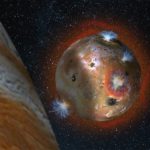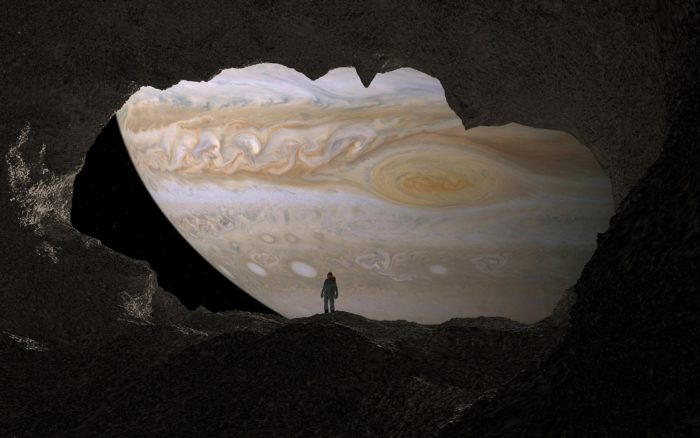
Alien Life In The Jupiter System And The Potential Colonization Of Europa
- By
- September 6, 2018
- September 28, 2021
- 12 min read
- Posted in
- Space, Our Solar System
We have examined previously the four gas giants that reside on the outer edges of our solar system, and more to the point their moons, which many scientists believe not only offer a chance for human colonization but also may already harbor alien life. One of the leading candidates for both scenarios is Europa, one of the main moons of Jupiter, the largest of all planets in our solar system.
Europa is an icy world where the sun would appear no bigger than a large star or bright planet to anyone stood on its surface. It is also one of the few places in our solar system where we know that liquid water exists. And where there is liquid water, there is the potential for life, or at the very least, the conditions in which to support life.

Artist’s impression of looking at Jupiter from Europa
And while we will look at Europa and the potential for alien life, as well as the upcoming experiments on the icy moon shortly, recent discoveries regarding the gas giant of gas giants in our cosmic neck of the woods perhaps give those scientists even more reason to proceed. Because while we are certain of water on Europa, there now may be the possibility of water on Jupiter also. Meaning, like Europa, alien life on the planetary behemoth “can’t be ruled out”.
With scientists predicting that we will “find alien life within twenty years”, despite the recent revelations of liquid water on Mars, the Europa-Jupiter system may indeed be the place we will find it. And while Europa is perhaps the leading cosmic body that could already support life and could certainly – technology provided – be a place we might attempt to colonize, several other moons in this particular system are also of exploratory intrigue.
Contents
- 1 “Life On Jupiter Is Not Beyond The Range Of Our Imagination!”
- 2 Speculative Evidence Of Intelligent Design?
- 3 Tectonic Activity On Europa!
- 4 The Europa Lander Mission
- 5 Might We One Day Set Foot On Europa?
- 6 Will Space Exploration Act As A Front For Corporate Gain?
- 7 If It Ever Happens, Who Do You Trust?
“Life On Jupiter Is Not Beyond The Range Of Our Imagination!”
Although it is extremely unlikely that life does, or even could, exist on Jupiter, at least how we understand it, a recent discovery of water clouds within the famous Great Red Spot has made scientists do a double-take of sorts on the chemical make-up of the region and the potential consequences to life thereof.
While humanity has collectively known of Jupiter’s existence going back to antiquity, it was only in 1830 when the Great Red Spot was first observed. [1] Within it, a space that can host around three or four Earth-sized planets, a vicious wind storm continually rages. These storms are monsters in themselves, with winds reaching speeds in excess of 400 miles per hour.
However, recent discoveries confirm the distinct (and predicted) presence of water clouds [2] within the Great Red Spot. An astrophysicist at Clemson University, Mate Adamkovics, while cautious of making an automatic connection between the presence of liquid water and the potential for life would state that while “it appears very unlikely, life on Jupiter is not beyond the range of our imaginations”. We should note again, though, that Adamkovics also stated that this was still “very unlikely”.
He would further state that, although not proven, it could very well be the case that water played a “critical role in Jupiter’s dynamic weather patterns”. If we can get a collective grasp on this wild weather, then it will not only help us understand the workings of Jupiter, but also, in theory, other cosmic bodies we might one day explore further, including any of the 79 moons that orbit Jupiter, or indeed some of the other satellites of the outer planets of our solar system.
The short video below looks at these revelations.
Speculative Evidence Of Intelligent Design?
The studies are due to move on to look at the entire planet next. If the results replicate elsewhere on the gas giant, then that would suggest significant “water-based” activity previously unknown to us. However, if it is limited to the Great Red Spot, then we have to ask, why? What might be special about this area? And more to the point, is it a natural, albeit freak, cosmic occurrence?
Or might, as speculative a suggestion as it is, it be an indication of intelligent design? Something purposely created in a specific part of the planet to harness and “create” water. And with this in mind, might the Great Red Spot, already a wonder of the universe from the human perspective, become something similar to the Mega Hex of Saturn? A similarly “suspicious” anomaly that has many in the conspiracy world convinced it is of such design.
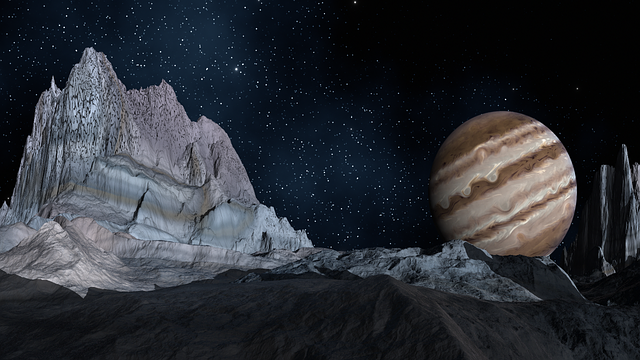
Artists impression of Jupiter from Europa
We will look at one of Jupiter’s main moons, Europa, in a moment. It is widely accepted that of all the moons and planets in our solar system it would be one of the most likely to support life. In relation to any speculative similarities between the Mega Hex of Saturn and the Great Red Spot of Jupiter, though, it is perhaps interesting that the other leading celestial destination predicted to be able to support life is Enceladus, one of the main moons of the ringed planet. Might we find, if we do attempt one day in the future to colonize one or both of these moons that another colony already exists? One perhaps from long ago? Or, perhaps more worryingly depending on circumstances, one that remains in operation today?
Tectonic Activity On Europa!
While further study of Jupiter will continue, one of its main moons, Europa, is many scientists’ leading prospect for life elsewhere in our solar system. In December 2017 scientists claimed they had evidence of “sliding tectonic plates” [3] under the thick icy crust on the surface of the enigmatic celestial body. This activity further increases the possibility of “alien life” existing in the huge oceans beneath Europa’s surface. Assistant professor at the Department of Earth, Environmental and Planetary Sciences, Brandon Johnson, would state that it is this tectonic activity that “offers a way to supply the nutrients it (life) would need”.
The tectonic activity on Earth is due to the “cooler” planet’s slabs entering the hot mantle and sinking into it. In doing so, this causes movement nearer the surface. However, as Europa is an icy world, there is debate as to whether such activity occurs in the same way. One theory is that such tectonic movement could be caused by sufficient salt in the water beneath the icy surface. If this is the case, and the oceans were effectively similar, or even the same as those on Earth, then the possibility of life existing there almost rockets upwards.
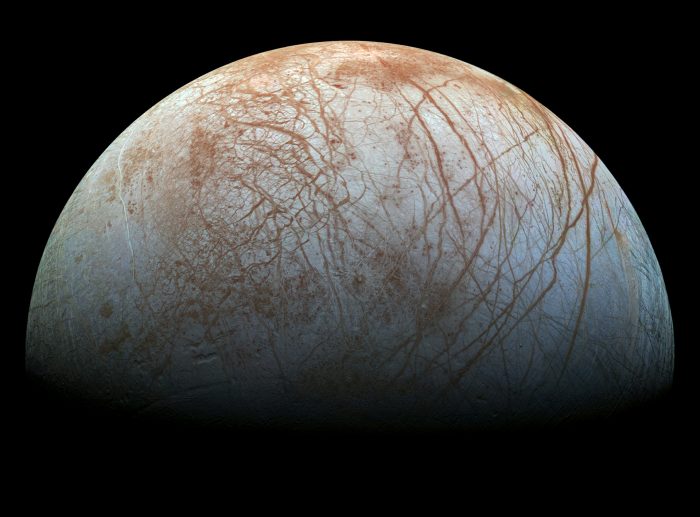
Close-up of Europa
In the summer of 2018, further reports coming from NASA would state that alien life, albeit in trace or microbe form, may be “just a centimeter beneath the surface” [4] of Europa. Furthermore, providing the correct landing spot was established, this would allow NASA scientists to test for such life in the (relatively) immediate future as a deep-drilling mission wouldn’t be required. An initial fly-by mission is set to launch in 2022. Hopes are a lander will follow that would search directly on the surface.
Discovery And Drawn-Out Exploration Of An Icy World
We will examine some of the planned and proposed missions to Europa in a little more detail shortly. For now, though, we will turn our attention to the early exploration of this fascinating moon.
Although we have been aware of the Europa (along with Jupiter’s other three major moons, Ganymede, Io, and Callisto) since it was first discovered by Galileo Galilei in January 1610, most of the intricate details we know today remained unknown until the flyby missions of the late twentieth century.
For example, the Pioneer 10 captured images of the moon during its flyby of Jupiter in November 1973, with Pioneer 11 doing likewise in November of the following year. Although the images were of poor quality by comparison to those we enjoy in the contemporary era, they were the first actual close-up pictures of the enigmatic moon.
Half a decade later in 1979, the Voyager probes captured similar if altogether much more detailed images of Europa, revealing in detail its icy surface. It was these images that first sparked the legitimate speculation that liquid water might exist on Europa. You can see the contrast between those two missions below, with the Pioneer picture on the left and the Voyager picture on the right.
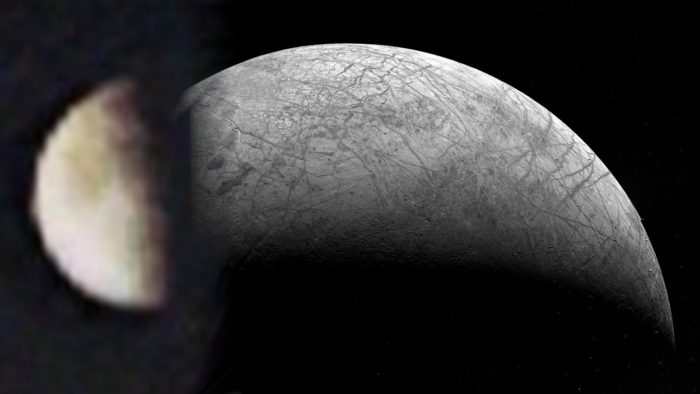
The first image of Europa from the 70s (left) and a much clear image from the late-1990s (right)
It wasn’t, however, until the Galileo missions from 1995 to 2003 when some of the intricate details that we know today we learned. The Galileo probe not only orbited around Jupiter for eight years, but it also performed several close flybys of Europa. And as it did so, it continued to add to what we know of this most fascinating icy world orbiting around our solar system’s largest planet.
An Abundance of Ideas And Proposals
Of course, there are various further missions in the pipeline for this region of the solar system [5] over the coming decades. The European Space Agency, for example, also plans missions to Jupiter. And while they will concentrate their research on the gas giant’s other main moons, Ganymede and Callisto, they will still perform two close fly-bys of Europa in order to “complement” the more in-depth studies by NASA.
Although searching for life is not the top objective of these long-planned visits to the first of the outer planets, depending on what results they reveal, the follow-up missions very well may be. With the ultimate goal, although still decades away (at least as far as the public is concerned) being a manned mission.
There are also several proposed missions that, while seemingly sitting in the long grass at the moment, might one day find themselves in revised form back on the presentation board. For example, there have been several orbiting missions proposed with various means of landing a probe on the surface, or of conducting extensive mapping missions.
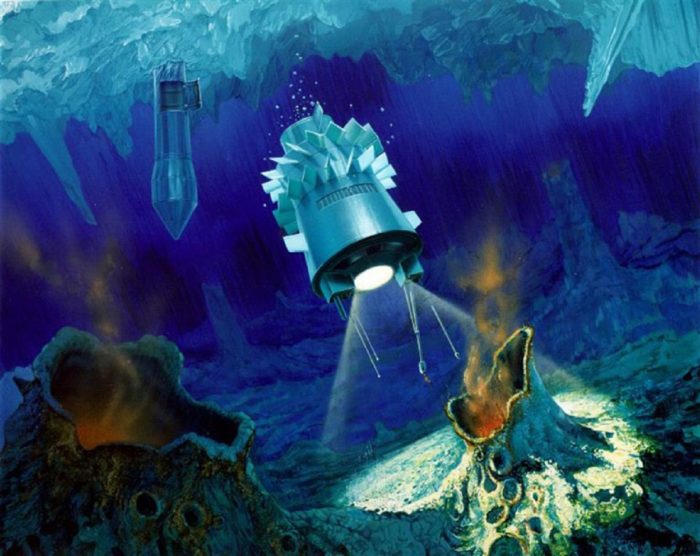
Artist’s impression of missions to Europa’s oceans
One of the most intriguing missions to be proposed, however, featured a “cyrobot” that would melt its way through the deep blanket of ice until it found itself in the ocean below. It would then release a “hydrobot” that would venture off to explore the alien waters, gathering information, and even potential lifeforms as it did so. There are, however, concerns about how to ensure that such a device remained free of contamination of Earth-organisms and ultimately, corrupting the research carried out.
There is one particular landing mission proposal that appears to have a better chance than most at, literally and figuratively, getting off the ground.
The Europa Lander Mission
Without a doubt, one of the most intriguing missions in the pipeline is the Europa Landing Mission (although it has yet to receive the budgetary green light, there are hopes that the program may still be launched in the 2020s). Concept funding continues, however, with NASA looking to explore Europa through the Ocean Worlds Exploration Program – an arm of NASA dedicated to the exploration of oceanic worlds of the solar system.
What’s more, one of the main aims of the Europa Lander is to not only successfully land a probe onto the surface but to find evidence of biosignatures – essentially, signs of life. It will search for these in the suspected oceans below the icy surface. While doing so, it will also seek to determine the actual composition of the liquid.
And while we don’t know for certain, it is estimated that Europa’s potential ocean beneath the thick blanket of ice that envelopes it is twice the volume of the oceans on Earth, meaning the potential opportunities for life are ample. We perhaps should note that around 70 percent of our own oceans and waters remain fully unexplored.
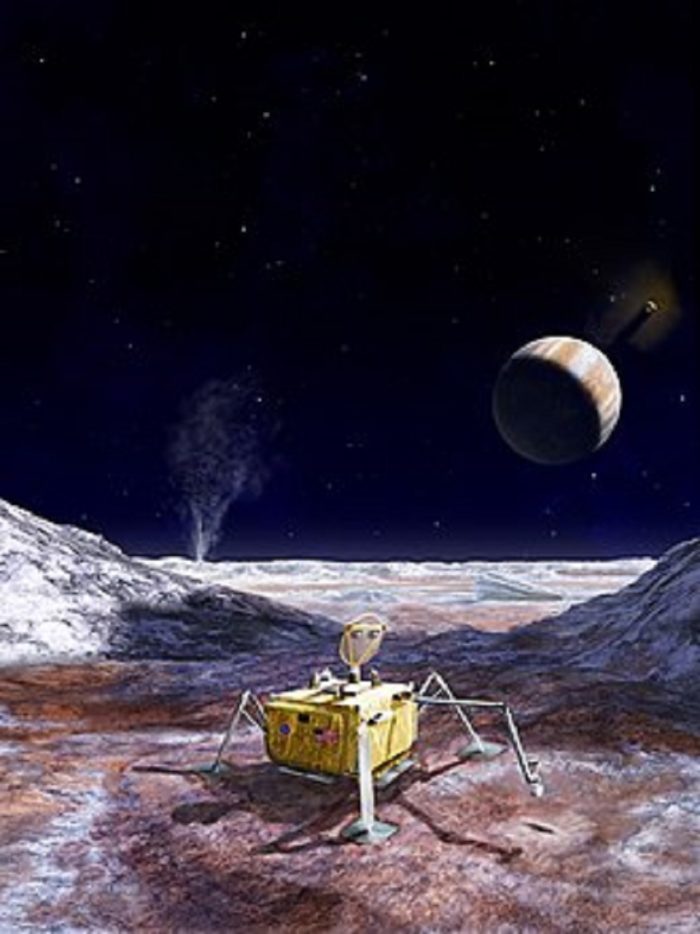
Artist’s impression of a lander robot on Europa
However, landing on the surface and performing these potentially historic and life-changing studies would be the last in several stages of the mission. The lander itself would be part of several separate modules that would be pieced together for the launch and then released when no longer required and allowed to drift off into space.
Following its launch and journey to Jupiter, it would spend around two years simply orbiting around the huge gas giant. As it did this, adjustments would be made to its speed and orbit, before it would finally head to Europa in order to land, releasing the Carrier Stage once in position to descend.
The Descent And Landing
What would be left of the spacecraft is named the Deorbit Vehicle (DOV). It is this section that will begin the journey down to Europa’s surface. As it does so, it begins to decelerate significantly. Eventually, the engine component of this part of the craft will be released, leaving the section named the Powered Descent Vehicle, which is itself two separate components. These are the lander itself, and the “sky crane system” which, with the aid of a tether, will send the lander to the surface with a “soft landing”.
And while seemingly largely smooth, there are jagged areas to the surface of Europa which means a predetermined and safe region will have to be identified. It is thought, however, that this landing could be performed to within only a 300 feet inaccuracy range. Incidentally, missions are planned to further photograph the surface of Europa – alongside NASA’s proposed Europa Clipper – which will be crucial in identifying potential regions for any landing mission.
The lander itself will spend anywhere from seven days to three weeks capturing, sending, and analyzing data from below the icy surface. However, it is not known how quickly the high amount of radiation that it will be exposed to may cause any system failures or shutdowns. With this in mind, the lander itself would likely require specialized protective materials in order to increase its life span against the barrage of radiation it will receive.
While the lander mission to Europa will almost certainly become a reality in the near future, there is still much to be worked on and worked out beforehand. Of course, at least in theory, the sooner a successful landing takes place, the closer we will be to seeing a manned mission to Europa.
Might We One Day Set Foot On Europa?
How far we are from a manned mission to the icy world that is Europa perhaps depends on who you ask. While optimists will say we could successfully launch a trip inside a few decades, others believe any human exploration of Jupiter, if indeed it does ever happen, will be likely centuries away.
If a manned mission was to go ahead, [6] then, like other similar planned missions to cosmic bodies in our solar system, there would have to be a significant amount of robotic legwork having taken place first in terms of a base camp of sorts having been established. And that’s if a suitable landing spot is found. Even if the crew were to live in their landing vehicle as their base, then it would have to be large enough to sustain them and their supplies for the duration of the stay.
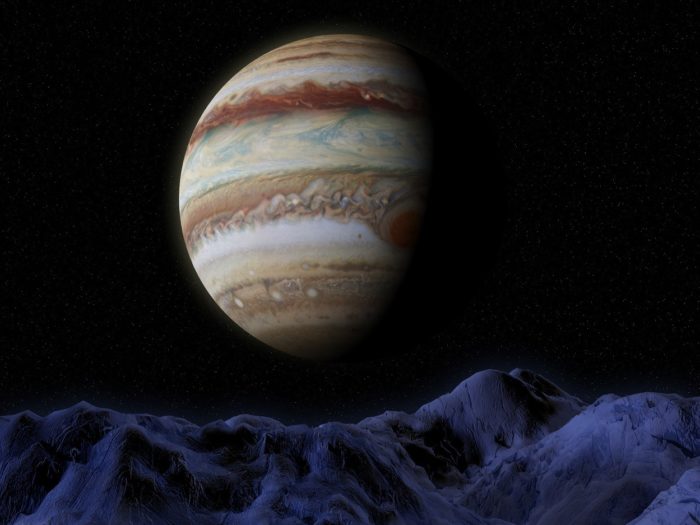
Artist’s impression of Jupiter from Europa
Of course, heat, at least on the surface, would be a problem, with a temperature hovering in the minus hundreds, any space suits and living facilities would also have to take this into consideration. Furthermore, research would have to be put into the potential locations of water plumes and where they might be, as well as technology in the foundations and structure of the base itself, which would likely have to withstand icequakes (essentially earthquakes).
Furthermore, wherever the base is established, it would need to be of a material that could protect from the intense radiation that constantly hits the planet. And should any exploration of the moon’s surface take place, this would have to be the case with any spacesuits and vehicles.
The location itself would undoubtedly be one of the most researched aspects of the potential mission, for more reasons than we might think.
Will Space Exploration Act As A Front For Corporate Gain?
A potential location for the base would be on the leading side of the moon itself, which has slightly less radiation exposure than the trailing side. What’s more, should a base be set up here, our crew would be witness to close-up and undoubtedly awe-inspiring views of Jupiter itself, which would appear over 20 times larger than our moon does to us on Earth.
In fact, this close proximity to the gas giant, depending on the advancements of technology, might also offer further incentives for establishing a base in Europa.
An aspect to space exploration that we need to consider is the potential discoveries of data from previous (in theory) successful landing missions. If valuable minerals are discovered on Europa that can be mined for monetary gain, then that will likely increase the chances of such missions there.
Indeed, future exploration might depend upon them being the front and official face of otherwise interplanetary corporate mining operations. If we return to the (relative) close proximity of Jupiter from Europa combined with assumed advances needed to establish a manned base on its surface already being in place, mining missions to the upper atmosphere of Jupiter, even using preprogrammed robotic vehicles, could also be a possibility.
Given that this valuable cargo would have to be transported back to Earth, we would also begin to consider the fact that space tourism might be introduced in order to further finance such missions and programs. Whether potential space guests remain in orbit around the Jovian system or check into a specially built hotel on the surface itself with a room facing Jupiter, perhaps remains to be seen.
If we do ever set on foot on Europa, the video below takes a look at the potential conditions we might find there.
If It Ever Happens, Who Do You Trust?
So, while many will be watching Mars, and even the Moon, over the coming years for more revelations and some of the much-anticipated private space missions to our closest celestial neighbors, the real action might be taking place one cosmic door along, on the moons of Jupiter. And even on the planet itself.
Perhaps, as unlikely as it may be, a privately funded mission will take place. And, depending on what new technologies are developed and made available, maybe those missions might indeed send humans to the icy world of Europa, or Jupiter, or even farther out. Indeed, as technologies, know-how, and capabilities develop here on Earth, the race for information in outer space will undoubtedly intensify. As will, no doubt, the conspiracies and disinformation. And in this speculative space race, who do you trust?
That last question is perhaps most urgent around the eventuality that “life” was discovered? Or even evidence of past life?
Perhaps we should also consider, as outrageous as it might be to many, the legends and myths of ancient times that speak of “gods” who came from a distant, aquatic world, as well as the many sightings of the UFOs over our own oceans and seas in modern times. Might there be connections between them?
Might it be, if there is a huge ocean beneath the icy surface of Europa that could support life, that it once was, and possibly continue to be, the home of these mysterious visitors of long ago? And might they be the same mysterious visitors that many report in contemporary times?
While Jupiter has long fascinated human beings, it might be its orbital servant, Europa, that yields the most intriguing finds.
The video below looks at this region of space in a little more detail.
References
| ↑1 | Jupiter’s Great Red Spot: A Swirling Mystery, NASA, August 4th, 2015 https://www.nasa.gov/feature/goddard/jupiter-s-great-red-spot-a-swirling-mystery |
|---|---|
| ↑2 | Scientists ‘can’t rule out’ alien life on Jupiter after shocking discovery, Chris Ciaccia, New York Post, August 31st, 2018 https://nypost.com/2018/08/31/scientists-cant-rule-out-alien-life-on-jupiter-after-shocking-discovery/ |
| ↑3 | Jupiter’s moon Europa could support alien life, scientists announce after finding activity under its shell, Andrew Griffin, The Independent, December 6th, 2017 https://www.independent.co.uk/news/science/europa-jupiter-alien-proof-tectonic-plate-movement-activity-heat-life-latest-planet-a8095116.html |
| ↑4 | Alien life might be hiding just a centimetre beneath surface on Jupiter’s moon Europa, Nasa scientists find, Andrew Griffin, The Independent, July 24th, 2018 https://www.independent.co.uk/news/science/alien-life-proof-jupiter-europa-moon-nasa-crust-a8460151.html |
| ↑5 | Can Europa Support Life? NASA Picks Tools to Study Jupiter’s Mystery Moon, Alan Boyle, NBC News, May 26th, 2015 https://www.nbcnews.com/science/space/can-europa-support-life-nasa-picks-tools-study-jupiters-moon-n364966 |
| ↑6 | What Would It Be Like to Live on Jupiter’s Moon Europa?, Joseph Castro, Space, March 3rd, 2015 https://www.space.com/28705-how-to-live-on-europa.html |
Fact Checking/Disclaimer
The stories, accounts, and discussions in this article may go against currently accepted science and common beliefs. The details included in the article are based on the reports, accounts and documentation available as provided by witnesses and publications - sources/references are published above.
We do not aim to prove nor disprove any of the theories, cases, or reports. You should read this article with an open mind and come to a conclusion yourself. Our motto always is, "you make up your own mind". Read more about how we fact-check content here.
Copyright & Republishing Policy
The entire article and the contents within are published by, wholly-owned and copyright of UFO Insight. The author does not own the rights to this content.
You may republish short quotes from this article with a reference back to the original UFO Insight article here as the source. You may not republish the article in its entirety.
